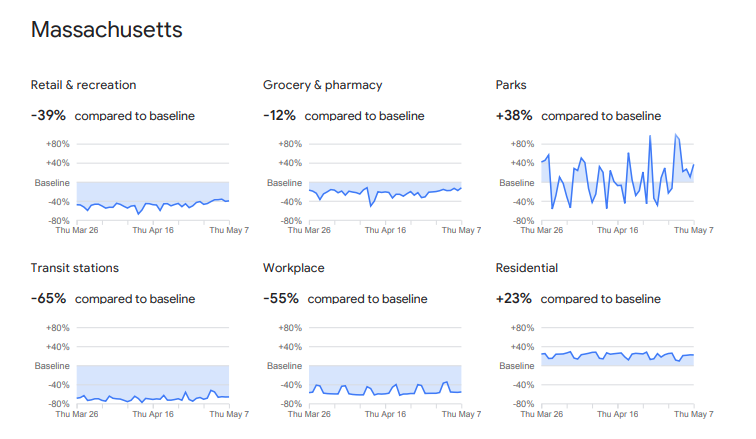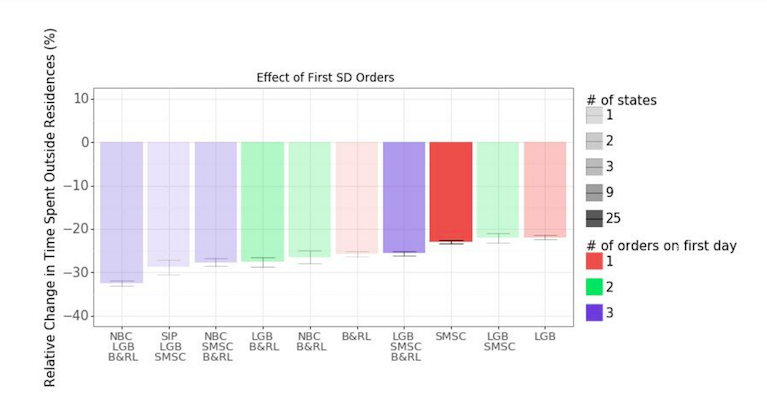保持身体距离的最佳政策是什么? Check Google (Data).

Social distancing (or “physical distancing”) mandates have become the main way that state and city governments are working to curb the spread of the new coronavirus. But how much do states of emergency, stay-at-home orders, shuttering non-essential businesses, and other policies and guidelines actually keep people from moving around and coming into contact with each other?
State mandates intended to promote physical distancing—especially limits on bars and restaurants—do reduce the amount of time people spend away from places of residence, according to a new study co-led by a School of Public Health researcher in collaboration with Google as part of the COVID-19 Community Mobility Reports project.
The study, available as a preprint on arXiv ahead of peer review and journal publication, finds that state-of-emergency declarations resulted in a 10-percent reduction in time spent away from places of residence, one or more physical distancing policies resulted in an additional 25-percent reduction after a week (and a 33-percent reduction in visits to retail and recreational locations), and subsequent shelter-in-place mandates led to an additional 29-percent reduction in time spent out and about.
“Among those states that imposed only one physical distancing order first, the limits on bars and restaurants seems to be the single policy that was associated with the greatest reduction of population mobility,” says study co-lead author Gregory Wellenius, director of SPH’s Climate and Health program and professor of environmental health (appointment pending).
However, he notes that states with a combination of orders saw the biggest reductions in how much time people spent away from their place of residence and moved around, potentially contracting or transmitting the coronavirus.

The study also outlines how community mobility has varied across states and counties as different physical distancing mandates have come out. “A reasonable question for a local official or governor to ask is, ‘Which of these policies, or combination of policies, will give us the results that are best suited to the pandemic here, and the economy here, and the public health here in my state?” Wellenius says.
He and his collaborators on Google’s COVID-19 Community Mobility Reports project are working to provide more information to help answer those questions.
The reports use anonymized data (and cutting-edge differential privacy measures, which Wellenius and colleagues outlined in another recent paper) from users that have opted-in to this service, in much the same way that Google Maps shows how busy a particular location is. The Community Mobility Reports use these anonymized data to map trends in how the COVID-19 pandemic—and state-level policies to control it—are affecting where people are spending more or less time.
Wellenius, who directs SPH’s Program on Climate and Health, began a short-term position as a visiting scientist at Google Research in January. Much of his research uses new technologies and data sources to better understand and address the harms of climate change, and he was excited to work with Google’s health team to do just that.

“When the COVID-19 pandemic started, it was really a natural fit for our team to start brainstorming ideas about how Google could contribute meaningful insights to help guide the global public health response to the pandemic,” he says.
The team soon launched the COVID-19 Community Mobility Reports, and began using the data for research, looking for insights that could be useful to the pandemic response.
The new paper is the first of several that may come out of the project, Wellenius says.
“The ability to bring to bear so many resources on a focused problem so quickly is truly remarkable,” he says. “I see tremendous potential for collaborations between technology companies that have these engineering abilities and resources on the one hand, and academics and public health professionals who can inform and guide that research in the most meaningful ways possible,” he says.
Being part of this collaboration at such a pivotal moment in world history “has been a truly exceptional experience,” Wellenius says. “I am incredibly fortunate to have been in the right place at the right time.”